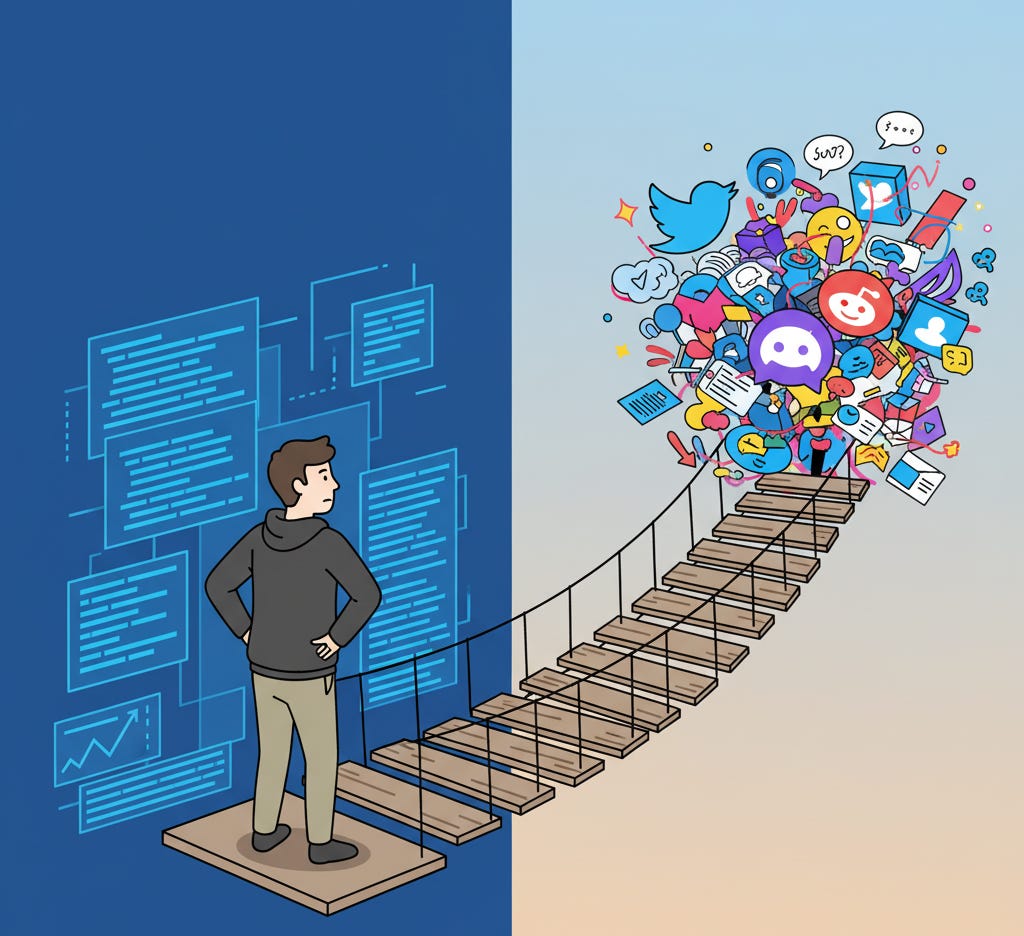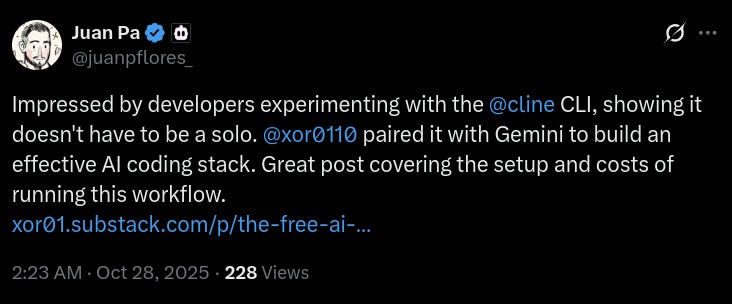Building Isn't Enough. A Developer's Hard-Won Marketing Lessons.
I Thought a Great Product Was Enough, Until I Was Wrong. A candid story of leaving the comfort of the command line for the chaos of marketing, facing failures, small wins, and hard lessons.
I’m obsessed with structure. Clean code, logical architecture, perfectly organized tasks, this is the world where I thrive. I can take an idea and hammer out a functional SaaS product in no time. For years, I operated under a simple, powerful, and utterly wrong assumption: if you build a great product, users will inevitably find their way to it.
Reality delivered a brutal lesson. After launching several high-quality applications with my partner, we were met with deafening silence. Our user count hovered below five. It was a painful awakening: creation is only half the battle. A product, no matter how brilliant, gathers dust without promotion. This is the candid story of my journey out of the comfortable certainty of the command line and into the chaotic, unpredictable world of marketing, a story of my failures, my small victories, and the lessons learned along the way.
Connect on social networks:
Failure #1: The “Build in Public” Monologue
Inspired by the indie hacker mantra, my first foray into marketing was “build in public.” I set up an X (formerly Twitter) account and, for ten consecutive days, posted daily progress reports. “Implemented authentication.” “Set up the database.” “Fixed a sync bug.” I documented my work with the diligence of a version control system, expecting a flood of questions, ideas, and early adopters.
The result? Nothing. Not a single like, comment, or question. I was speaking into the void.
The Post-Mortem: My mistake was fundamental. I wasn’t building in public; I was logging my work in public. My posts were dry technical reports, meaningful only to me. I failed to explain the why, the problem my product solved. I didn’t include screenshots to make the progress tangible. Most importantly, I never asked questions to invite a conversation. It was a monologue, not a dialogue. The lesson was sharp and immediate: marketing is the art of communication, not just the dissemination of information.
The Great Platform Experiment: Finding a Voice and a Home
The flop on X forced me to find a better home for my story. I needed a platform for deeper content, which sent me down a classic developer rabbit hole of “vibe-coding”, testing tools instead of creating. I considered a custom-built blog but knew I’d get trapped in endless configuration. WordPress was familiar, but the temptation to perfect plugins would be a fatal distraction. Ghost looked promising but felt expensive and isolated without a built-in recommendation network.
Ultimately, Substack won. It offered everything I needed out of the box: a clean interface, email subscriptions, subscriber exports, and even tweet-style “Notes.” While its Stripe-based monetization isn’t available in my country, it became the perfect, zero-friction hub for my core content.
With my home base established, I adopted a hub-and-spoke distribution strategy:
For Short-Form Content: I used X, Bluesky, and Threads for quick updates and announcements. My surprise favorite became Peerlist.io, where a responsive developer community provided my first real taste of engagement with likes and comments on short posts.
For Long-Form Content: I syndicated my full Substack articles to platforms like Dev.to, Hashnode, and Medium. I’m still trying to crack Habr.com (they’ve rejected my posts so far), and IndieHackers requires a paid plan to post, limiting its utility. The undisputed traffic champion, however, was Reddit and Hacker News (news.ycombinator.com). A simple link with a compelling title can unleash a massive wave of visitors.
The Hunt for Users: Automation vs. Conversation
My next strategy was to proactively find users experiencing the exact “pains” my products solve. I turned to automation. For my Reddit summarization extension, I set up keyword trackers in Google Alerts and F5bot (which proved more effective) using queries like:
site:reddit.com (”can someone summarize” OR “need a tldr” OR “how to save this thread”)
The alerts worked, surfacing dozens of relevant conversations daily. But when I jumped in with comments offering my tool as a solution, the results were dismal. No view spikes, no new users. My cold, contextless replies were just more noise.
The breakthrough came from an entirely different direction: Discord. I abandoned broad alerts and targeted niche communities. In five different productivity-focused servers, I posted a simple, honest message: “I’m building an AI Kanban board and looking for beta testers.”
People responded. For the first time, I was having actual conversations. Users asked questions, offered ideas, and a few even agreed to test the product. While they didn’t stick around as long-term users, it was a pivotal moment. I realized I needed to stop thinking in terms of a faceless “audience” and start engaging with individual people. One genuine dialogue is infinitely more valuable than a thousand automated pings.
The Reddit Gauntlet: A Goldmine Guarded by Traps
Reddit is both the most promising and the most perilous platform. It hosts massive, concentrated communities of my target users, but its moderation system is a minefield for newcomers.
My first account, three weeks old, was permanently banned for a few seemingly harmless comments. I quickly learned that any link can be flagged as spam, and any hint of self-promotion can trigger an instant ban from moderators. I even began to suspect the existence of shadow bans, where your posts are visible only to you. (Pro-tip: you can check your status at reddit.com/appeals. If it says there’s nothing to appeal, you’re in the clear).
After several failed attempts, I developed a new “account warming” strategy:
Week 1: Do nothing but browse and leave a few upvotes daily.
Week 2: Start leaving one or two short, helpful comments per day. No links.
Week 3: Post “innocent” content like memes or funny images in relevant subreddits to gradually build karma.
Week 4+: Only now, begin cautiously posting more substantial content, always prioritizing value over promotion.
To craft posts that felt natural and dodged the AI spam filters, I developed a workflow using Perplexity Pro. I’d generate drafts with multiple models (like Sonnet and GPT-5), then use a third (Gemini) to merge the best parts. My prompt was specific: “Write a human-like, community-tailored post that is light on ads.” I would then manually inject personal stories and screenshots to add authenticity and transparency, which is crucial for building trust.
Lessons Forged in Failure
This journey has been defined more by setbacks than successes. Our Product Hunt launch for Genie Prompt Optimizer, an AI prompt extension, was a major disappointment. We got a couple of dozen visits and almost zero installs. We were just another tool in a sea of AI products, and users were spooked by Google login, fearing we’d steal their emails for spam lists.
At that moment, I nearly gave up. But through these failures, a few core truths emerged.
1. Persistence Is More Important Than a Perfect Plan. The most critical skill I’ve developed is stubbornness. It’s the will to keep publishing, keep engaging, and keep trying, even when faced with silence and dismal metrics. We learned to shorten our planning horizons and focus on the next right action.
2. Cherish Every Single User. The goal shifted from acquiring a large “audience” to deeply understanding a few individuals. The first users who offer detailed feedback are more valuable than thousands of passive visitors. They are the ones who tell you if you’re building something that truly matters.
3. To Get Your Product Noticed, You Have to Be Noticed. Your personal brand is a powerful marketing tool. When I genuinely praised the Cline CLI tool in an article, their developer advocate retweeted me, giving my profile a small but meaningful boost. Authentic appreciation builds bridges and creates goodwill that direct advertising never can.
The New Blueprint: From Solo Products to a SaaS Team
These lessons prompted a strategic pivot. Instead of focusing on promoting individual products, we are now building our brand as a SaaS development team. We create content about our entire journey, the development process, the marketing struggles, the lessons learned.
My partner is now focused on finding influencers who can become the face of our products in exchange for a revenue share. Meanwhile, I continue to build our media presence, creating case studies, user testimonials, and honest articles like this one. We are building a brand that is larger and more resilient than any single project.
Conclusion: The Journey Has Just Begun
This is not a success story, not yet. It is a story about a developer obsessed with structure learning to navigate the chaos of marketing. It’s about trading the clean logic of code for the messy, unpredictable, but ultimately rewarding work of human connection.
If you are a developer standing where I was a few months ago, my advice is this: start now, start small. Don’t wait for the perfect product or the perfect plan. Post a screenshot on Peerlist. Ask a question in a Discord channel. Write one article on Substack. Embrace the failures, because each one contains a lesson. Your story is your most valuable asset, share it honestly. The journey from code to content is long, but it has just begun.
*This was written using Elicito Ai






